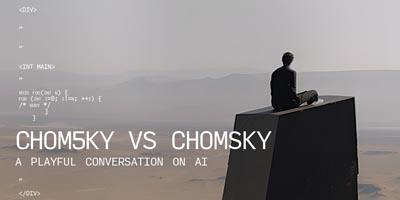CHOM5KY vs CHOMSKY: A playful conversation on AI is a VR experience that allows people to converse with an AI model, Chom5ky, based on digital traces of the leading contemporary philosopher and linguist Noam Chomsky. I believe Chomsky is an inspiring scholar to build an AI with due to his pessimistic and skeptical stance on artificial intelligence. He recently stated in an interview that AI contains “plagiarism, apathy and obviation,” and the machine learning system will always be superficial and dubious. Thus, Chom5ky’s existence would provoke reflections on the competence of human minds and the distinctiveness between humans and AI.
Having had the honour to talk with the producer Marie Pier Gauthier, I was informed that Chom5ky was built and trained using various AI models, including Microsoft voice recognition and translation and ChatGPT3. An extensive amount of Chomsky’s digital traces, such as his interview transcripts and academic literature, were edited and archived in the Knowledge Base, which is computed to output the possible response when specific keywords are detected. However, Chom5ky would turn to ChatGPT3 to generate responses when dealing with unfamiliar questions. When I asked whether Chom5ky’s viewpoints are completely inherited from Chomsky, she mentioned that the goal is not to build a deep fake and a mere duplicate of Chomsky but a Chomsky-inspired figure. Thus, the creators intentionally left Chom5ky’s voice with some robotic features as a reminder of its artificial nature. She also expressed that this conversation is meant to be a playful experience, and we shall not be shy to ask any question, from “Do you like peanut butter?” to sophisticated philosophical questions.
During the VR experience, one of the intriguing aspects is that it was designed for multi-users, from two to four people. Chom5ky asked me to solve a puzzle with another user, yet we were unable to communicate verbally as we were both wearing VR headsets. By pushing the wooden cubes and aligning them in line, we engaged in minimal yet thought-provoking teamwork. Chom5ky led us to appreciate one of the unique traits of humans: collaboration. I also noticed that although Chomsky has made many influential political criticisms, Chom5ky was very silent on controversial politics-related questions and refused to take moral responsibility. For instance, I asked about its idea of the US-China relationship, and it merely responded with, “I think it’s just fine.”
Having been taking a course on the philosophy of mind, Chomsky’s universal grammar theory that humans innately acquire linguistic capacities is also of interest to me. Chom5ky showed me a massive pile of cubes with “rock” written on them, indicating that Large Language Models require large-scale data input and constant training to recognize and categorize objects. By contrast, children only need incomplete and even minimal exposure to vocabulary to identify objects. This is a vivid and descriptive demonstration of Chomsky’s optimistic attitude toward human minds and their infinite potential.
In conclusion, this inspiring conversation with an AI model reminds me to keep questioning “what is it to have a mind?” and what makes humans as an entirety or me, as an individual, unique.
Created by Sandra Rodriguez, CHOM5KY vs. CHOMSKY is a co-production by the National Film Board of Canada and SCHNELLE BUNTE BILDER




